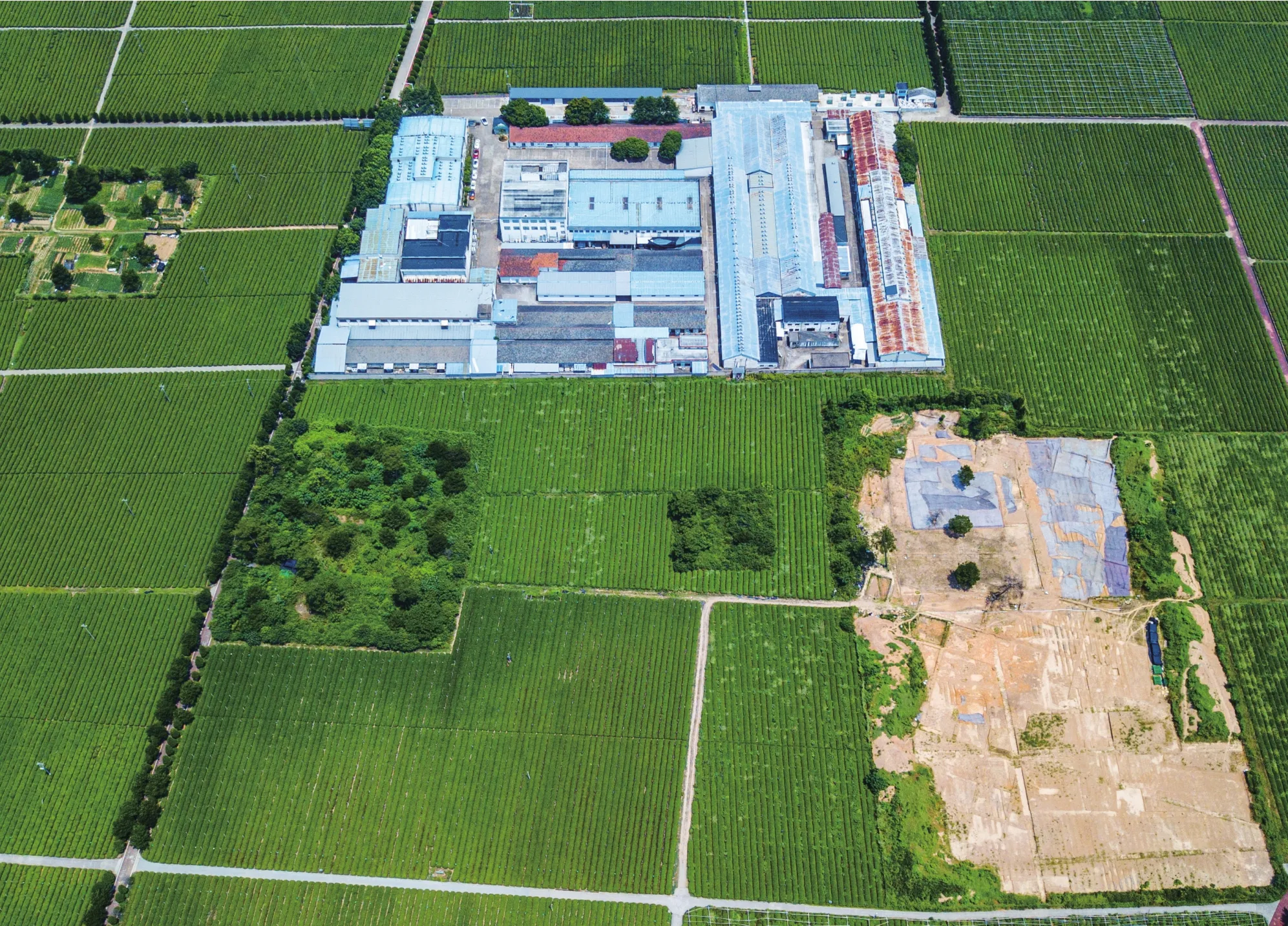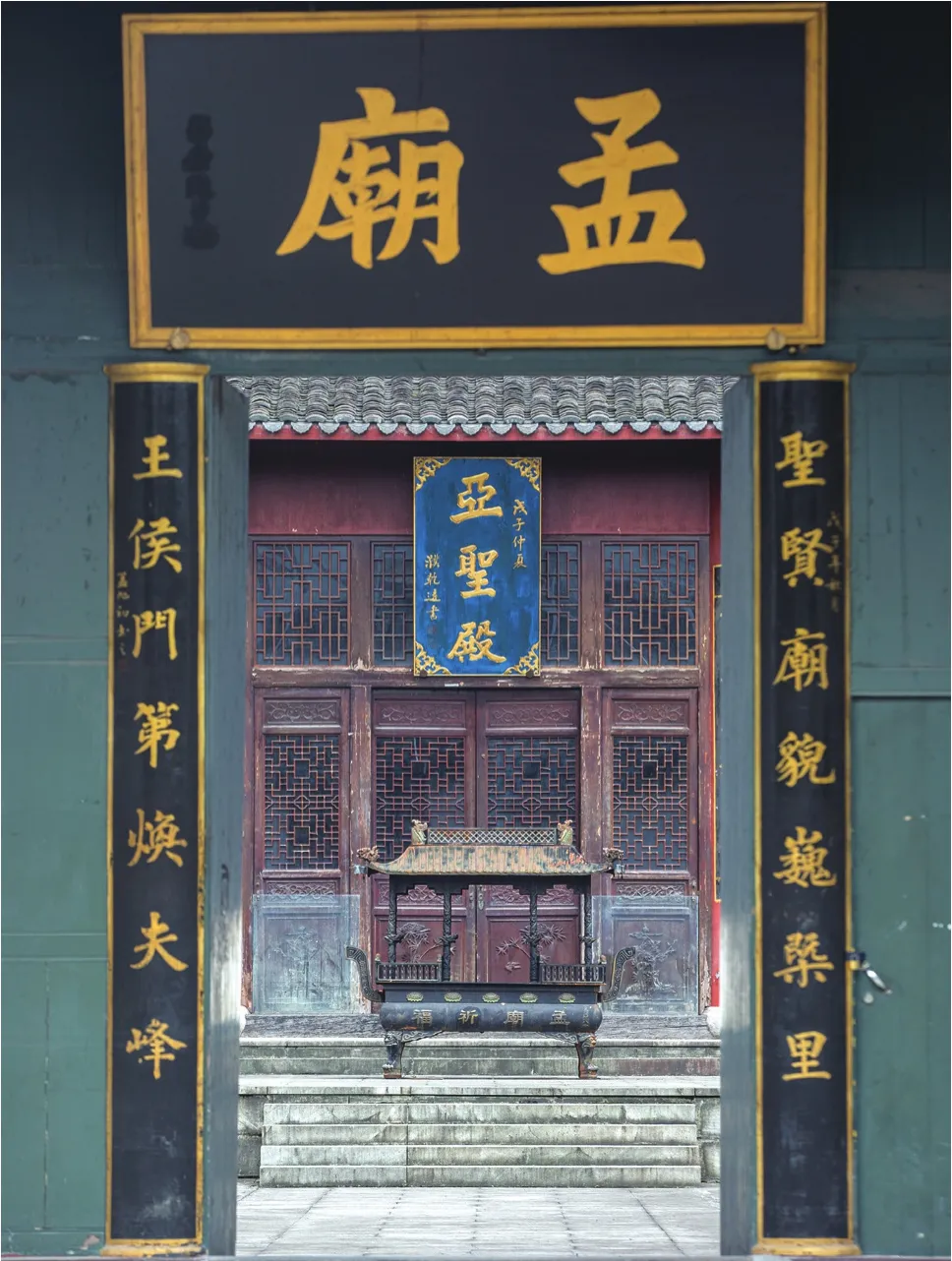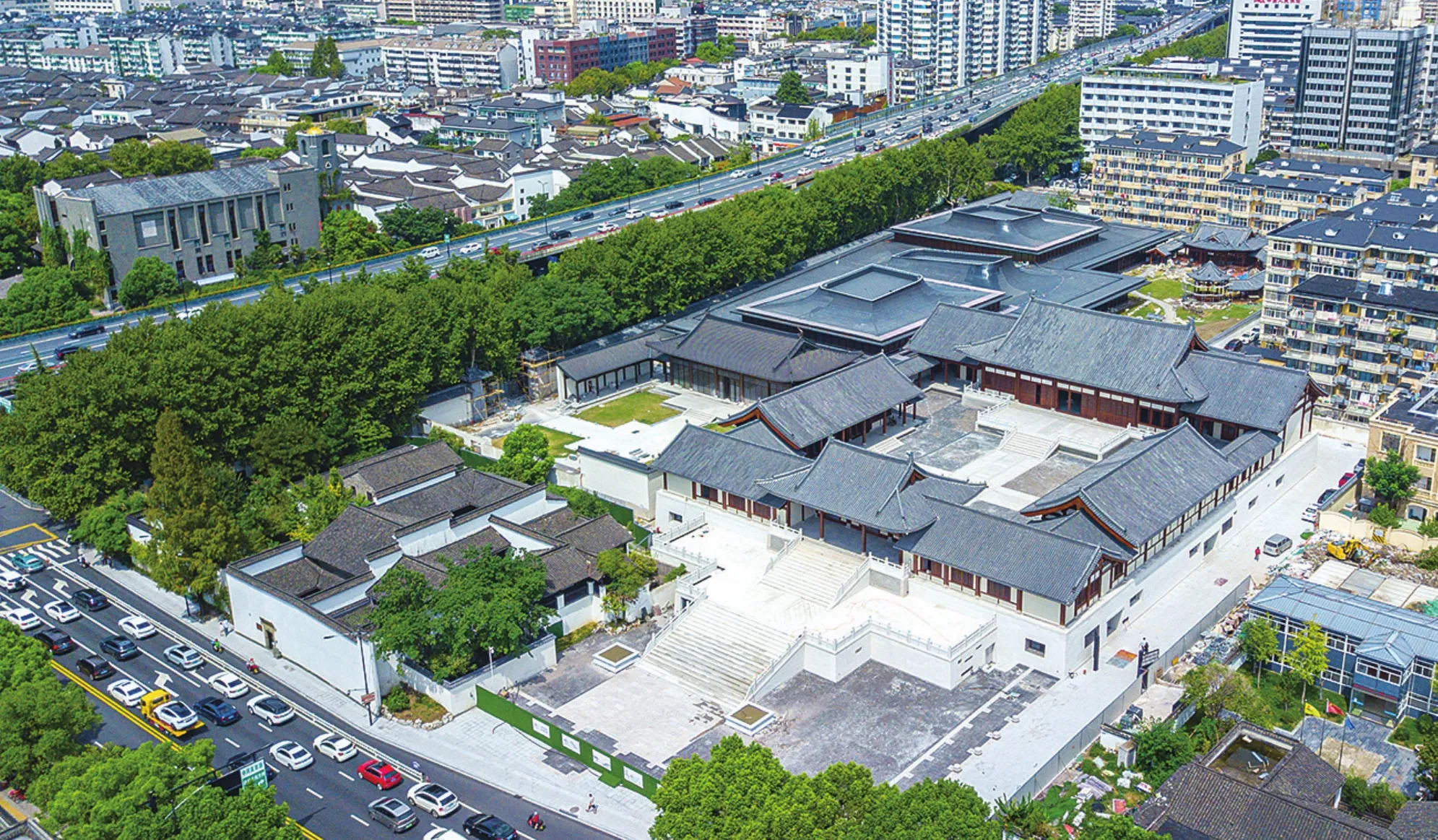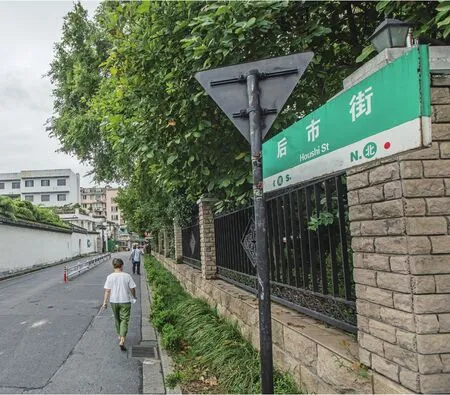孟皇后与绍兴的帝陵
文/余夕雯

俯瞰宋六陵一号陵园(下左)和二号陵园(下右)遗址。据史料记载推测,画面左上方为“宋哲宗孟皇后陵”遗址区域。陈中秋/摄An aerial view of No. 1 (down on the left) and No. 2 (down on the right) mausoleums of the Six Mausoleums of the Song dynasty. The mausoleum on the upper left side is said to be the place where Empress Meng was laid to rest. Photo by Chen Zhongqiu.
杭州是南宋的皇城,而南宋的皇陵却在绍兴,后人把这里称为“宋六陵”。这是现存江南地区分布最集中的皇家陵园。
很多人好奇,帝陵为什么会选在绍兴?这是因为一个女人—孟皇后。
要知道,不是每个皇后死后都可以入葬皇陵的,而她不但入葬皇陵,还是启动南宋皇家陵园的第一人。
从今年的7月仲夏到10月金秋,杭州西湖博物馆总馆南宋官窑馆区进行了一场《国音承祚—宋六陵考古成果展》,这是宋六陵十年考古成果的首次集中展出。
这场展览,让很多观众记住了孟皇后这个名字。
冷宫娘娘三十年 她是被皇室除名的女人
1073年,北宋熙宁六年,洺州(约在今河北省永年县)一户大宅子里诞生了一个漂亮的女孩,父母给她起名孟相,字媚韵。
宋代对子女的教育重视程度和我们现代类似。从小,孟氏就和哥哥弟弟一起上学、一起习武。

诸暨市应店街镇十二都村“南孟故里”的孟庙。陈中秋/摄The Mencius Temple in Yingdianjie township, Zhuji city. Photo by Chen Zhongqiu.
她天资聪慧,在私塾中深受夫子喜爱。
聪明多才之外,孟氏还有一个良好的家世—她是孟子第46世孙,她的爷爷是眉州防御使兼马军都虞候孟元。
名将之后,这位知书达理的大家闺秀将来注定不会嫁得平凡。但谁也没有想到,她可以成为母仪天下的六宫之主。
16岁时,孟氏被征召入宫,经过层层选拔和考核培训,终于,在她20岁那年,嫁给了北宋第七位皇帝,17岁的宋哲宗赵煦,成为了其第一任皇后。
俗话说,“女大三,抱金砖”。但故事并没有往浪漫爱情的走向发展,因为选中她的,并不是宋哲宗本人,而是他的奶奶、垂帘听政多年的高太后。
在强势祖母的阴影下,年少的哲宗内心充满了压抑和郁闷,对她安排来的皇后,自然也是爱不起来。
“包办婚姻”一年后,高太后去世,只生了一位公主没能生出皇子来的孟皇后,在后宫的安稳日子也到了头。
与此同时,宋哲宗在后宫中开始专宠容貌俏丽的宫女刘清菁,彻底冷落了皇后。
心机颇深的刘美人开始不惜一切手段谋害孟皇后。
机会终于来了。
1096年,孟皇后的女儿福庆公主突然夭折,刘氏借孟皇后给公主做法事的机会,派人向哲宗告状,说皇后在宫中行厌胜之术,企图谋害皇上。
哲宗一听大怒,立刻下旨废了孟皇后。
于是,23岁的孟皇后被迫住进了寂寞荒凉的瑶华宫,成为一名道姑。
遭受丧女之痛加上废后的双重打击,此时的孟皇后已经心力交瘁。
瑶华宫虽名为宫,实际上只是几间简陋的破屋,围成一处小院,荒草丛生,等同于一座“冷宫”,没有皇帝的允许,她不能与外界接触。
在冷宫里,孟皇后日夜思念着不幸夭折的女儿,外面不时有皇家消息传来:刘美人被进位为贤妃,不久生了一个儿子,成了新任皇后。再然后,新皇后的儿子也死了。又过了4年,一个惊人消息传来,哲宗驾崩了,年仅25岁。
政局的变化,连带着孟皇后的命运也改变了。
宋哲宗同父异母的弟弟宋徽宗即位后,把嫂子孟氏召回宫中,复立为元祐皇后。但复立归来,后宫中又是一场大戏,这一次,她一样无法把握自己的命运,短短一年时间,孟皇后再次成为宫斗牺牲品,被发配回到瑶华宫,继续做了道姑。
再次被打入冷宫,就没上次这么幸运了,漫长的幽闭生活持续了近30年,外面的一切都与她无关,她就在冷宫里一直等到了51岁,才又被这个世界想起。
因祸得福当太后 她是宋高宗最感恩的女人
1127年,金兵攻下了北宋首都,北宋亡。宋徽宗、宋钦宗及皇室成员都被金兵掳走,整个北宋王朝风雨飘摇。
孟皇后因不在皇室名册中,又正巧瑶华宫起火,她搬到了宫外侄儿家中暂住,躲过一劫。
金军撤退后,开封城留下了以张邦昌为首的傀儡政府。张邦昌自忖没有号召力,在众人一致要求赵宋皇室的人出来主事的呼声中,京城的废后孟氏被请回来主持大局,张邦昌册其为“宋太后”,请她垂帘听政。
从这里开始,要改口叫孟太后了。
事实证明,当初高太后选人的眼光没错,面对国破家亡,孟太后显示出了她非凡的智慧和勇气。她不但没有对带给她大半生委屈和伤害的宋室王朝反目相向,反而毅然决然地在兵荒马乱中开始收拾烂摊子,并且当机立断,要寻找宋室遗孤,以期光复。
孟太后派自己的心腹侄儿找到了皇室幸存者—宋徽宗第九子、“康王”赵构,并亲写书信劝其称帝。
1127年,21岁的赵构在南京应天府(今河南商丘)登基,成为南宋开国皇帝宋高宗。
在宋高宗登基当天,孟太后就撤帘还政。登基次日,宋高宗感恩这位“母妃”,立即册封她为元祐太后,后又改元祐太后为隆佑太后,并声称孟太后有安定社稷的大功,是奸臣诬陷她的品德,他还命令国史院把她的功绩记录下来,并昭告天下百姓。
平战乱守牌位 她是开启“宋六陵”的第一人
南宋朝廷刚稳定了没两年,因为一场兵变,孟太后再一次被推上了风口浪尖。
1129年,建炎三年,面对金兵不断南侵,宋高宗从南京一路狂奔到杭州,仓促中,以凤凰山的旧州治(北宋杭州治所)为行在所。
当时,扈从统制苗傅、威州刺史刘正彦发动兵变,胁迫高宗将皇位禅让于三岁的太子,并请孟太后再度垂帘听政。
叛军兵临城下,高宗被困在了鼓楼上,双方谈判不成。
这时候,56岁的孟太后离开凤凰山皇宫,来到叛军面前。她表面上敷衍叛将,暗中则调兵遣将。她召见大将韩世忠的妻子梁红玉,让韩将军尽快带兵勤王。待内乱平息,宋高宗一复位,孟太后立即再次撤帘。
内乱是平息了,但金兵又继续追来,宋高宗、孟太后不得不颠沛流离、亡命天涯。这次,他们兵分两路,高宗往沿海跑,孟太后则带着祖宗牌位逃往西南洪州(今江西南昌),她带着祖宗牌位还有一个重要意图,万一高宗被金兵追上了,她还可以指定新的继承人。
随着政局改变,南宋政权逐渐稳定。1131年,宋高宗南迁至越州,改年号为绍兴,寄托“绍(继承)祚(国统)中兴”之意。
刚稳定下来,他立即就派人去接回孟太后。但太后毕竟年纪大了,再加上一路颠簸,实在是经不起折腾,1131年4月,孟太后在绍兴卧龙山行宫崩逝,那年她59岁。
高宗悲痛万分,要将“母后”安葬在哪里?成了他心里一件头等大事。
在为孟太后选择墓葬地址时,南宋朝廷的礼官们看中了绍兴会稽山余脉的富盛宝山下一片谷地,认为这里东南高、西北低,与北宋帝陵地址相似。
这里被视为临时的安息之所,期望着有朝一日可以魂归河南巩县的祖陵,故将此山命名为“攒(cuán)宫山”。“攒”有“暂时安置”的意思,就像临安被视为临时都城一样。
浙江省文物考古研究所宋六陵发掘项目负责人李晖达说,根据目前的考古发现,还无法确定,礼官们当时究竟是站在哪座山上看中了这片谷地。但这是宋高宗向世人宣告的一个信号,表达了他收复中原的政治愿望和决心。“皇陵体现了国家最高等级的丧葬制度,从北宋传承的文化和传统来考量,当时以什么方式让皇陵连贯着政治意识,这是个重大问题。”

已完成主体建筑建设的德寿宫遗址保护展示工程暨南宋博物院 ( 一期 )。陈中秋/摄The reconstructed Deshou Palace, which is also the Southern Song Museum. Photo by Chen Zhongqiu.
孟太后去世七年后,1138年,南宋王朝正式定都临安(今杭州)。在其后的100多年时间里,先后有7位宋代皇帝(宋徽宗、宋高宗、宋孝宗、宋光宗、宋宁宗、宋理宗、宋度宗)和7位皇后下葬于绍兴这座庞大的皇家陵园,后人称之为“宋六陵”。
女中豪杰爱喝酒 她的后人定居诸暨“南孟故里”
孟太后一生荣辱沉浮,是智商情商双双在线的女中豪杰,她有一个爱好—喝酒。
据《宋会要辑稿》记载,在孟太后薨逝后,有一天,宋高宗对大臣们说:“太母恭慎,于所不当得,分毫不以干朝廷。太母性喜饮,朕以越酒烈,不可饮,令别酝,太母宁持钱往沽,未尝肯直取也!”
高宗认为,绍兴酒度数太高了,让人专门酿造低度酒给她喝,她不愿意,宁可花私房钱买酒喝,不愿给朝廷增加负担。意思是夸她谦恭谨慎,很守本分。
对待自己的族人,她也是严格要求,孟氏一族也因此成为最不爱搞事情的外戚,满门忠烈。
其中,她的侄子孟忠厚就是典型代表。
他追随、护驾宋高宗和孟太后一路南下到江浙一带,最后定居在绍兴诸暨。
《宋史·孟忠厚传》记载,孟忠厚“远避权势”。南宋朝廷特别推恩孟氏,南孟一族被五世封王。
孟忠厚还是孟子第47代孙,是孟子后裔在南方始祖。
1170年,奉宋孝宗御旨,诸暨县令初建“孟子庙”,宋高宗还手书“仁寿堂”匾额为诸暨孟氏宗祠堂号。
孟姓是目前诸暨应店街镇第一大姓,专门有一个“南孟故里”,人数在两万以上。
回到杭州,也有一个地方跟孟太后有关。
为了追思孟太后,在南宋定都杭州后,宋高宗专门为她建了宅院。《梦粱录》记载:“昭慈圣献孟太后宅,在后市街。”
南宋时的后市街,与凤凰山南的后宫连着,不仅是酒楼瓦肆聚集的地方,也是一帝三后的府院坐落处。一帝,指的是南宋末代皇帝,三位皇后分别是孟皇后、南宋光宗的李皇后以及理宗的谢皇后。
今天再走后市街,或许会有一点时空交错的恍惚。孟太后虽然只在杭州待了半年,或许也曾到后市街走过,到酒楼里买酒喝。
她不像历史上那些凭借能力和智慧一路所向披靡,开启“大女主”人生的女政治家们,而是在江山社稷最艰难的时候挺身而出,功成后懂得及时归政放权,绝不贪恋权力。
一个弱女子,一步步如履薄冰,为大宋王朝续了百年的命。岁月长河滚滚,这位贤德智慧与胸襟气度并存的皇后,理应被今天的我们记住。

西湖博物馆总馆南宋官窑馆区内举行的《国音承祚—宋六陵考古成果展》。陈中秋/摄A visitor is seen at the Exhibition of Archeological Discoveries of Songliuling at the West Lake Museum. Photo by Chen Zhongqiu.
Empress Meng and Imperial Tombs in Shaoxing
By Yu Xiwen

杭州凤凰山东麓的南宋皇城遗址。陈中秋/摄The Southern Song Imperial City Ruins at the foot of the Phoenix Mountain in Hangzhou city. Photo by Chen Zhongqiu.
Hangzhou was the imperial city of the Southern Song dynasty (1127-1279), while the imperial tombs of the Southern Song dynasty were located in Shaoxing, which was later referred to as the “Six Mausoleums of the Song dynasty”. This is the most concentrated royal mausoleum in the southern part of China.
Why Shaoxing?
That is because of a woman — Empress Meng. Not every empress could be buried in the imperial tomb after death, yet Empress Meng was buried there. It was also for her reverence that the Southern Song royal mausoleum was initiated.
Within the main hall of the West Lake Museum in Hangzhou, an archeological exhibition is underway, the first-ever centralized exhibition of the 10-year archaeological achievements of the “Six Mausoleums of the Song dynasty”. This exhibition has made many visitors acquaint with the name of Empress Meng.
In 1073 in the Northern Song dynasty (960-1127), a beautiful girl was born in a mansion in Mingzhou (nowadays Hebei Province roughly), and she was named Meng Xiang.
Meng went to school and practiced martial arts with her brothers from a young age.
She was gifted and intelligent, and was well-liked by her tutors in the private school.
Her family background was extraordinary — she was the 46th generation granddaughter of Mencius (372-289 BC), and her grandfather was Meng Yuan, the defensive governor of Meizhou and the inspector-in-chief of the cavalry.
At the age of 16, Meng was conscripted into the imperial court and, at the age of 20, selected as the spouse of the 17-yearold Emperor Zhezong (1077-1100), the seventh emperor of the Northern Song dynasty, and became his first empress.
Since she was chosen by Empress Dowager Regent Gao(1032-1093), the emperor’s grandmother, Meng was given the cold shoulder.
A year into their marriage, Empress Dowager Regent Gao died, and Empress Meng, who had only one daughter, had reached the end of her peaceful days in the harem. At the same time,Emperor Zhezong began to favor Consort Liu, ignoring Meng completely.
In 1096, Empress Meng’s daughter died suddenly and Liu used this occasion to accuse her of performing witchcraft against the emperor. Emperor Zhezong was so furious that he immediately stripped Empress Meng of her title.
As a result, the 23-year-old Meng was forced to live in a desolate Daoist nunnery, lonely and heartbroken.
While she pined for her daughter invariably, the world outside kept changing: Liu was promoted to be a consort, soon gave birth to a son, and became the new empress; then the new empress’ son died; after another four years, shocking news came that Emperor Zhezong died at the age of 25.
The fate of Meng also changed. After the accession of Zhezong’s half-brother, Huizong (1082-1135), he recalled Meng,his sister-in-law, back to the court and reinstated her as Empress Yuanyou. But she once again fell victim to another harem drama and was sent back to the nunnery just a year later.
However, she was not as lucky as last time. Her secluded miserable life lasted for nearly 30 years before she was remembered by the world again, at the age of 51.
In 1127, the Jurchen forces captured the capital of the Northern Song dynasty. Most of the imperial family was taken captive, and the whole Northern Song dynasty was in a state of turmoil.
After the retreat of the Jurchen, a puppet government headed by Zhang Bangchang (1081-1127) was installed in Kaifeng. Zhang thought he did not have the power to appeal to his people, so he invited Meng, who was living outside the court and escaped the attack, to come back and take charge.
From here on, the title of regent should be added to Meng’s name.
Watching her ruined state and starving people, Empress Regent Dowager Meng showed her extraordinary wisdom and courage. She sent her nephew, the ninth son of Emperor Huizong to find the survivor of the imperial family and persuaded the latter to claim the throne.
In 1127, the 21-year-old Zhao Gou (1107-1187) ascended the throne as the founding emperor of the Southern Song dynasty,Emperor Gaozong of Song. On the day of Gaozong’s enthronement,Empress Regent Dowager Meng stepped down from regency. In gratitude for her act, Emperor Gaozong gave her the title Empress Dowager Longyou, praising her achievements in stabilizing the state, and ordered for her merit to be recorded and publicized.
After only two uneventful years, the peaceful Southern Song dynasty was stirred up again.
In 1129, driven by constant Jurchen invasion southward,Emperor Gaozong ran wildly from Nanjing to Hangzhou, where he took an old government building at the foot of the Phoenix Moutain as his residence.
At that time, a rebel army coerced Emperor Gaozong to abdicate the throne and asked Empress Dowager Meng to take charge of the government again.
To break the stalemate, the 56-year-old Meng left her palace on the mountain and came to the rebels. She perfunctorily dealt with the rebel generals on the surface and secretly deployed her troops. As soon as Emperor Gaozong was restored, she immediately stepped down from regency again.
The civil unrest was quelled, but the Jurchen continued to come after them, and Gaozong and Meng were forced into exile again. This time, they parted ways: Gaozong went along the east coast, while Meng ran towards the southwest to Hongzhou (now Nanchang city in Jiangxi province) taking with her ancestral tablets, with which she could appoint a new successor if Gaozong got caught up.
With changes in the political situation, the Southern Song dynasty gradually stabilized, and in 1131, Gaozong moved south to Yuezhou and changed the title of his reigning era to Shaoxing.
The moment he settled down, Gaozong immediately sent someone to invite Empress Dowager Meng to return to the imperial court. But Meng was too old to withstand the bumpy return trip and died in her palace in Wolong Mountain, Shaoxing in April 1131, at the age of 59.

诸暨市应店街镇十二都村“南孟故里”孟庙中陈列的孟皇后相关碑刻。陈中秋/摄Stone tablets bearing inscriptions about Empress Meng are displayed at the Mencius Temple in Yingdianjie township, Zhuji city. Photo by Chen Zhongqiu.
Gaozong was so grief-stricken. Where best to bury “Her Majesty” became a priority on his mind.
When choosing a burial site for Empress Dowager Meng,the court officials of the Southern Song dynasty looked at a valley under Fushengbao Mountain in the remainder of Shaoxing’s Kuaiji Mountains, which was considered high in the southeast and low in the northwest, similar to the terrain of the Northern Song emperors’ tombs.
It was regarded as a temporary resting place with the expectation that one day the souls of the deceased would return to the ancestral tomb in Gongxian county, Henan province, so the mountain was named “Cuangong Mountain”. The character “cuan”means “temporary”, just as Lin’an was regarded as a temporary capital city.
Li Huida, head of the excavation project at the Zhejiang Institute of Cultural Relics and Archeology, said that based on the current archeological findings, it is not possible to determine exactly which hill the ceremonial officials were standing on at the time, looking at the valley. But it was a signal that Emperor Gaozong announced to the world, expressing his political desire and determination to reclaim the Central Plains. “The imperial tomb is a funeral system that reflects the highest rank of the state,and it was a major issue at that time to present the culture and tradition inherited from the Northern Song dynasty in a way that made the imperial tomb coherent with political consciousness.”
Seven years after Empress Dowager Meng’s death, in 1138,the Southern Song dynasty officially set its capital at Lin’an(present-day Hangzhou). Over the next 100 years, seven Song emperors and seven empresses were buried in the vast royal mausoleum in Shaoxing, known to later generations as the “Six Mausoleums of the Song dynasty.”
Empress Meng, a woman who braved out ups and downs,had a hobby: drinking.
Gaozong thought that the Shaoxing wine was too strong,and asked people to brew some wine of a lower alcoholic content specifically for her. But Meng refused that special treatment,preferring to spend her private money on drinking wine rather than adding to the burden of the court. After her death, Gaozong highly praised her for being modest, prudent and responsible. Empress Dowager Meng also treated her clan members strictly, making her clan the least fussy and most loyal of all the royal relatives.
Back in Hangzhou, there is also a place related to Empress Dowager Meng.

后市街。陈中秋/摄The Houshi Street. Photo by Chen Zhongqiu.
To memorialize Her Majesty, after the capital of the Southern Song dynasty was set in Hangzhou, Emperor Gaozong built a residence specifically for her. As theorrecords, “The residence of Empress Dowager Meng is in the Houshi [or Back Market] Street.”
In the Southern Song dynasty, the Houshi Street connected with the harem in the south of Phoenix Mountain was not only a place where restaurants and taverns gathered but also a place where the palaces of one emperor and three empresses were located. The one emperor was the last emperor of the Southern Song dynasty,and the three empresses were Empress Meng, Empress Li of the Southern Song Emperor Guangzong (1147-1200), and Empress Xie of Emperor Lizong (1205-1264).
Today, walking the Houshi Street again, you may feel a bit of time-space crisscross, although Empress Dowager Meng only stayed in Hangzhou for half a year. Perhaps she also walked to the street to buy some wine for herself from one of the taverns.
She was not like those female politicians in history who had been invincible with their ability and wisdom and lived a life of an “ever-victorious heroine”. Rather, she came forward at the most difficult time for her state and people, and afterwards she withdrew from regency decisively to return power to the emperor,never craving for more.
Starting as a weak woman, Empress Meng headed forward step by step like walking on thin ice, and under her protection,the Song dynasty got to survive for a hundred years longer. As the years rolled by, this virtuous, wise, broad-minded empress with great vision, deserves to be remembered by us today.

